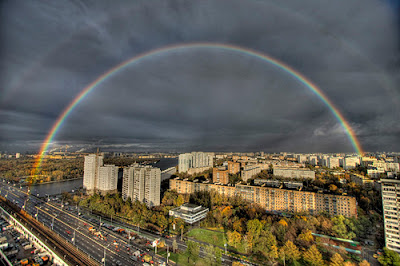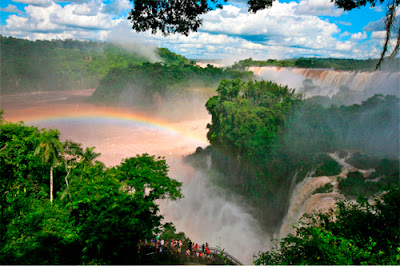Rainbows are natural phenomenon caused by refraction when light passes through water particles in the atmosphere. They are beautiful and has all the colours in the visible spectrum namely Violet, Indigo, Blue, Green, Yellow, Orange and Red; starting with Red on the outside.
In some occasions a second Rainbow is visible outside of the primary rainbow. But the second one will not be as bright as the first and they will have the colours in inverse order. i.e. Starting with Violet on the Outside.
The vibrant colours of the rainbow and its arc shape add a visual impact to photographic compositions and as a result rainbows have always been the favourite subject for Nature Photographers.
In some occasions a second Rainbow is visible outside of the primary rainbow. But the second one will not be as bright as the first and they will have the colours in inverse order. i.e. Starting with Violet on the Outside.
The vibrant colours of the rainbow and its arc shape add a visual impact to photographic compositions and as a result rainbows have always been the favourite subject for Nature Photographers.
 |
| Photo By Cavin |
Some Rainbow Facts
- Rainbows caused by sunlight always appear in the section of sky directly opposite the sun.
- Rainbows occurring at sunrise or sunset will have red as the predominant colour.
- If there occurs a second rainbow, the colours of the secondary rainbow are inverted compared to the primary bow, with blue on the outside and red on the inside.
- If there are two rainbows in the sky the area between the two rainbows will be visibly darker than the rest of the sky, and the area inside the bright rainbow (first one) will be noticeably lighter.
- Rainbows can be formed by many forms of airborne water. These include not only rain, but also mist, spray, and airborne dew.
- Rainbows typically have a life span of few minutes and during this period they vary in intensity. A rainbow may start off faintly but it will gradually increase in colour and intensity and reach a peak before again gradually fainting away.
How to Find a Rainbow
The two main ingredients of a rainbow are sunlight and airborne moisture. So we can expect to see a rainbow then there is bright sunlight and rain at the same time the rainbow may occur either when it’s raining or right after the rain.
 |
| Photo By Alex E Proimos |
Background
The best backgrounds to shoot rainbows are dark and uncluttered. Dark rain clouds and mountain peaks make good backgrounds for photographing rainbows. Since you cannot change the background; the other options available are to change the shooting angle or to physically move so as to obtain a different framing or to zoom in to focus upon a certain portion of the rainbow.
Foreground
While photographing rainbows, you could either photograph just the rainbow or you should shoot a scene with rainbow as one of its elements. If you are going for the second option then pay attention to the foreground. Foreground elements chosen wisely would not only add visual interest to the shot but also lead the viewer’s attention to the primary focal points.
 |
| Photo By Nicholas T |
Aperture
Choice of aperture value depends upon how much of the scene you would like to be in focus. If you have included some foreground elements in your composition that are close to the camera; then you should choose a small aperture. Some value greater than f/11 to ensure that all elements in the scene are in sharp focus.
 |
| Photo By J Anand |
To obtain greater colour saturation try underexposing your rainbow shot by 1 or 1.5 f stops. Better try bracketing your shots.
Composition Tips
When composing your rainbow shots think of two things
First is how much of the rainbow is visible to me. Can I see the entire arc and both the end points, or can only the centre portion is seen or can I see one end point where it hits the ground.
Second point is the kind of equipment that I have with me. Do I have an ultra wide angle lens that could cover both the end points of the rainbow? Or do I have a zoom that could focus on either a portion or on one end of the rainbow.
Remember the points where the rainbow hits the ground / horizon is the most interesting factor in a rainbow photo.
If the entire arc as well as the end points of the rainbow is visible to you and you have a wide angle lens then it is better to centre the arc and place the whole of rainbow in the upper third of the frame. If only a portion of the rainbow or an end point is visible then align the end point with some interesting element in the scene. It would be worth considering the rule of thirds when framing. As the end point of the rainbow will be a natural point of interest it will lead the viewer’s eye to the interesting foreground element.
Polarizing Filter
A polarizing filter could be used to bring out the vivid colours of the rainbow. But be careful to polarize only slightly else you will end up completely eliminating the rainbow out of your shot rather than intensifying the colour. Experiment by rotating the filter to see the effect it has on contrast levels, reflections, saturation etc. and select the settings that produce the best results.
 |
| Photo By Robert S Donovan |
Tripod
Tripods are a must have for shooting rainbows, the combination of low light conditions and a small aperture setting is reason enough. Not to mention the effect of the polarizing filter on the shutter speeds.
In the next article we will discuss about Photography - Nature and Wildlife Photography - How to Photograph a Spider's Web
Post a Comment